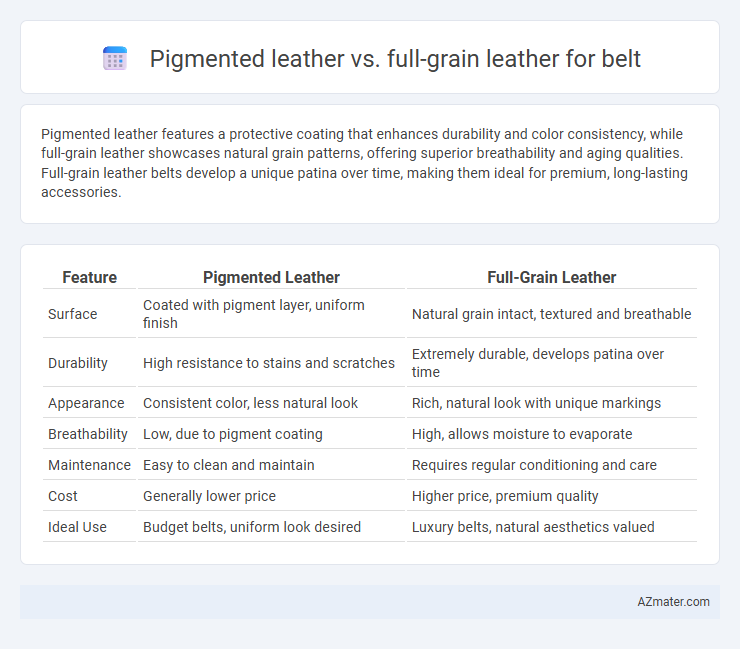Pigmented leather features a protective coating that enhances durability and color consistency, while full-grain leather showcases natural grain patterns, offering superior breathability and aging qualities. Full-grain leather belts develop a unique patina over time, making them ideal for premium, long-lasting accessories.
Table of Comparison
| Feature | Pigmented Leather | Full-Grain Leather |
|---|---|---|
| Surface | Coated with pigment layer, uniform finish | Natural grain intact, textured and breathable |
| Durability | High resistance to stains and scratches | Extremely durable, develops patina over time |
| Appearance | Consistent color, less natural look | Rich, natural look with unique markings |
| Breathability | Low, due to pigment coating | High, allows moisture to evaporate |
| Maintenance | Easy to clean and maintain | Requires regular conditioning and care |
| Cost | Generally lower price | Higher price, premium quality |
| Ideal Use | Budget belts, uniform look desired | Luxury belts, natural aesthetics valued |
Introduction to Pigmented Leather and Full-Grain Leather
Pigmented leather features a durable, uniform coating that hides natural imperfections and enhances color consistency, making it resistant to stains and scratches. Full-grain leather retains the entire grain layer with natural markings, offering superior breathability, strength, and the ability to develop a rich patina over time. Both types serve distinct aesthetic and functional preferences in belt craftsmanship, with pigmented leather favoring durability and ease of maintenance, while full-grain leather emphasizes natural characteristics and longevity.
Key Characteristics of Pigmented Leather
Pigmented leather features a durable, uniform coating that enhances resistance to scratches, stains, and fading, making it ideal for belts exposed to frequent wear. Its surface is more resistant to water and dirt due to the protective pigment layer, resulting in less maintenance compared to full-grain leather. Unlike full-grain leather, pigmented leather typically lacks natural texture and breathability, but it offers consistent color and a smooth finish suitable for everyday use.
Unique Features of Full-Grain Leather
Full-grain leather belts showcase the natural grain and imperfections of the hide, offering unmatched durability and a luxurious patina that develops over time. Unlike pigmented leather, full-grain leather remains breathable and ages gracefully, enhancing its aesthetic appeal with each wear. The unique texture and strength derive from the intact top layer of the hide, making full-grain leather belts a premium choice for long-lasting and stylish accessories.
Durability Comparison: Which Lasts Longer?
Full-grain leather belts feature the entire grain layer, offering superior durability and resistance to wear compared to pigmented leather, which has a surface coating that can crack over time. The natural fibers and breathability of full-grain leather contribute to its longevity, often lasting decades with proper care. Pigmented leather belts may initially resist stains better but tend to show signs of aging and wear faster due to the weaker protective layer.
Aesthetic Differences: Appearance and Texture
Pigmented leather belts feature a uniform, glossy finish with a consistent color layer that conceals natural marks, resulting in a smooth and polished appearance ideal for formal styles. Full-grain leather belts showcase the natural grain and texture of the hide, including unique imperfections and a rich patina that develops over time, providing a rugged and authentic aesthetic. The texture of full-grain leather is more tactile and varies with use, while pigmented leather maintains a stable, less porous surface, offering different visual and tactile experiences.
Comfort and Flexibility in Everyday Use
Full-grain leather belts, made from the top layer of the hide, offer superior comfort and flexibility as they naturally mold to the wearer's body over time. Pigmented leather belts feature a protective coating that enhances durability but can feel stiffer and less breathable during extended wear. For everyday use, full-grain leather is preferred for its ability to soften and adapt, providing lasting comfort and ease of movement.
Maintenance Requirements: Care and Cleaning
Pigmented leather belts feature a protective coating that resists stains and moisture, making maintenance straightforward with regular wiping using a damp cloth and mild soap. Full-grain leather belts require more attentive care, including periodic application of leather conditioner to maintain suppleness and prevent cracking. Proper cleaning involves avoiding excessive water and using specialized leather cleaners to preserve the natural texture and durability of the full-grain leather.
Price Point Analysis: Cost vs. Value
Pigmented leather belts generally offer a lower price point due to the added pigment layer that masks imperfections and reduces processing costs, making them an affordable option for budget-conscious buyers. Full-grain leather belts, while more expensive, provide superior durability and develop a rich patina over time, delivering long-term value that often justifies the higher initial investment. Evaluating cost versus value reveals that full-grain leather belts are cost-effective over their lifespan, whereas pigmented leather belts serve well for short-term use or entry-level pricing.
Best Uses for Pigmented and Full-Grain Leather Belts
Pigmented leather belts offer enhanced durability and resistance to stains, making them ideal for everyday casual use or work environments where scratches and moisture are common. Full-grain leather belts feature natural texture and breathability, providing superior strength and a developing patina, perfect for formal wear or those seeking a high-quality, long-lasting accessory. Choosing between pigmented and full-grain leather depends on the balance of aesthetic preference and functional endurance required for the belt's intended use.
Choosing the Right Leather Belt: Factors to Consider
When choosing the right leather belt, consider durability and appearance: pigmented leather offers a uniform finish with added protection against stains but may hide natural grain details, while full-grain leather showcases authentic texture and develops a rich patina over time, indicating higher quality and longevity. Evaluate daily wear and maintenance requirements, as full-grain leather tends to age gracefully but demands more care, whereas pigmented leather is easier to clean and resists surface damage. Assess your style preferences and practical needs, balancing aesthetic appeal with functionality for the best belt choice.

Infographic: Pigmented leather vs Full-grain leather for Belt
 azmater.com
azmater.com